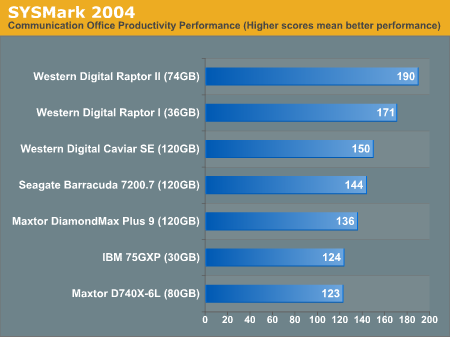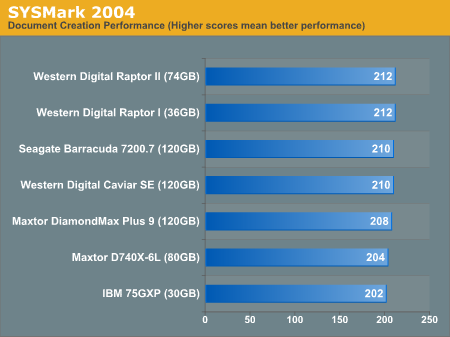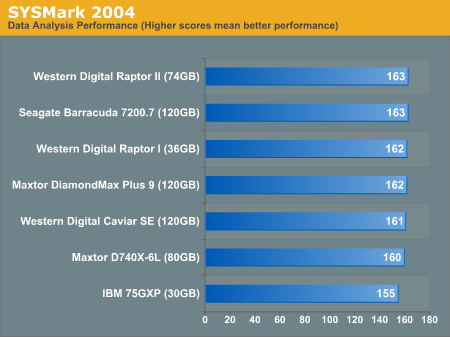Q2 2004 Desktop Hard Drive Comparison: WD Raptor vs the World
by Anand Lal Shimpi on June 7, 2004 12:05 AM EST- Posted in
- Storage
Overall System Performance - SYSMark (continued)
SYSMark's Office Productivity suite consists of three tests, the first of which is the Communication test. The Communication test consists of the following:
"The user receives an email in Outlook 2002 that contains a collection of documents in a zip file. The user reviews his email and updates his calendar while VirusScan 7.0 scans the system. The corporate web site is viewed in Internet Explorer 6.0. Finally, Internet Explorer is used to look at samples of the web pages and documents created during the scenario."

The Communication test tends to be very disk dependent and thus, we see significant differences between the drives. The advantage of a larger cache is evident, as the newer 7200RPM drives hold at least a 10% performance advantage over the older drives.
This test also shows a significant performance advantage for the Raptors. This is the first test in our suite that shows a substantial difference between the first and second generation Raptors, with the new Raptor outpacing the old one by 11%. The new Raptor also manages to offer a 27% performance advantage over the fastest 7200RPM drive in this comparison. What is very important about this advantage is that it is a 27% advantage, not in a disk only test, but in a real world test. Any situation where a drive is able to increase overall system performance by 27% is one that demands attention, especially if it isn't an unusual situation; in this case, it very much isn't.
The next test is Document Creation performance, which shows very little difference in drive performance between the contenders:
"The user edits the document using Word 2002. He transcribes an audio file into a document using Dragon NaturallySpeaking 6. Once the document has all the necessary pieces in place, the user changes it into a portable format for easy and secure distribution using Acrobat 5.0.5. The user creates a marketing presentation in PowerPoint 2002 and adds elements to a slide show template."

The biggest difference here is less than 5%, so there's not too much to talk about. The drives' impact on performance is basically negligible.
The final test in our Office Productivity suite is Data Analysis, which BAPCo describes as:
"The user opens a database using Access 2002 and runs some queries. A collection of documents are archived using WinZip 8.1. The queries' results are imported into a spreadsheet using Excel 2002 and are used to generate graphical charts."

Although you would think that Data Analysis would show significant differences in drive performance, this particular test still isn't as disk bound as the Communication test. The performance spread here is 5%.










50 Comments
View All Comments
SignalPST - Monday, June 7, 2004 - link
Great review, I must say. But one thing that would certainly interest alot of people including myself would be using RAID. We know that using multiple hard drives in a RAID array is very popular among gamers and almost every motherboard out now supports RAID as well. I'm sure it'll be quite interesting to see 4 of 74GB Raptors in RAID 0 in future reviews! It would also be interesting to see the different effects of stripe sizes configurations.Doormat - Monday, June 7, 2004 - link
What about putting some meta-data in there? Like current street price, length of warranty, etc. Also temperature would be nice.I'd kinda like to see some RAID tests too, I'm looking at RAID 5 for a bunch big drives for a video on demand system.
Speaking of, a big-drive comparison would be cool too. Where's that hitachi 400GB drive they announced a while ago?
Murst - Monday, June 7, 2004 - link
Hmm,well, I'm pretty sure that there should be a significant difference in system performance when your system runs out of RAM. When virtual memory takes over, I have seen the performance of my computer drop significantly. I was hoping that a benchmark could be made showing just how large of a difference could be seen when virtual memory is a significant source of data for program execution. There should be a noticable difference in this performance between different drives.
Also, it would be interesting to know if the file system on a drive makes a difference in performance. I have a feeling that if it does, it would be unnoticable, but nevertheless, unless its tested, we would never know for sure. I don't neccessairly mean the type of file system, either. Just as RAM can have different latency settings, so can a hard drive have different block sizes (and optimal block sizes).
Again, I'm not positive if this would make a difference in performance, but I'm just trying to think of practical tests for hard drive performance.
Anand Lal Shimpi - Monday, June 7, 2004 - link
Murst,Sorry, the last response must've been posted at the same time as yours :)
Both the Winstone and SYSMark tests use multiple applications running at the same time, but I do understand the point you're trying to make.
We do have a synthetic test that shows the benefit of defragging a hard drive, but I have yet to do significant investigation in to how that affects performance between drives other than it reduces it.
Take care,
Anand
Anand Lal Shimpi - Monday, June 7, 2004 - link
Must,The drives being tested are secondary drives only for the game loading tests and the theoretical IPEAK tests. The remaining Winstone and SYSMark tests all use the drive as the only drive in the system.
Take care,
Anand
Murst - Monday, June 7, 2004 - link
Hmm... let me clarify that. I believe that all of your tests were probably ran with no other programs executing. It would be interesting to see the difference in performance when a lot of page swapping is occurring (ie, fill up the page table by executing other programs and then run a benchmark).Oh, and I just thought of another issue... why not have a benchmark which evaluates a drop in performance of a drive with data that is, say, 60% fragmented as compared to mostly unfragmented data.
Murst - Monday, June 7, 2004 - link
Its nice to see a hard drive comparison. I will be building a new comp soon and I always wondered if I'd see a difference between drives.I do, however, have one concern. It seems like the drives you used were secondary drives in the system, with the operating system working off a different drive. I have always assumed that the largest benefit of choosing a very fast drive was to minimize the access and read times of a page fault (as I generally do not spend much time at all waiting for something to load). It would seem that none of your tests take this into consideration.
Thanks
Anand Lal Shimpi - Monday, June 7, 2004 - link
#1 - You're correct, the mentions of command queuing were leftover from some early tests on a new SATA controller with support for the feature. Those tests didn't make it into the article, and I've updated it accordingly.Take care,
Anand
jliechty - Monday, June 7, 2004 - link
#1 - I was under that assumption also. I do recall hearing of a controller chip that supported TCQ being in the works (or perhaps already available), but the question remains whether that chip has been put in any controllers that are on the market at this time?Anyway, I'm glad that my preciousss... er... my Raptor didn't do too badly, though for what I do I probably could have kept my old WD Caviar Special Edition and not noticed much of a difference, except for my wallet being heavier. :-(
RyanVM - Monday, June 7, 2004 - link
Doesn't the WD74GD require a controller which supports command queuing in order for that feature to be of actual use? And I was under the impression that no current SATA controllers support that function.